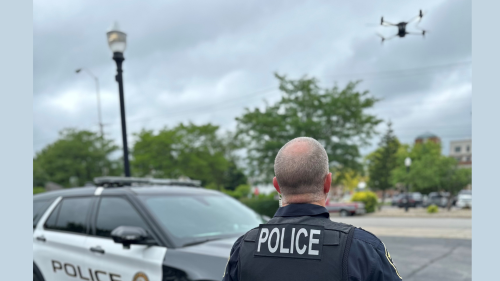Editor’s Note: A use case for generative AI is analyzing and synthesizing meeting notes. The rough notes I took during the session, “From Apprentice to Master: Artificial Intelligence and Policing,” were submitted to ChatGPT 4.0 with the prompt: “Use these notes to create a news article of 500 to 700 words for police chiefs on the panel discussion.” An additional prompt instructed ChatGPT to, “Add to this article, based on the notes, a checklist of immediate actions for a police chief to take to understand and prepare their agency for AI in policing.”
SAN DIEGO — In a recent panel discussion titled “From Apprentice to Master: Artificial Intelligence and Policing,” hosted by the International Association of Chiefs of Police in San Diego, California, law enforcement leaders from around the globe shared their insights on the emergence and integration of Artificial Intelligence (AI) in policing.
The eminent panel featured Donald Zoufal of the Illinois Association of Chiefs of Police, Shawna Coxon from An Garda Síochána, Dublin, Jonathan Lewin from INTERPOL Washington, Oscar Wijsman of the Netherlands Police Department, and Craig Allen, the chair of IACP Communications and Technology Committee.
Potential impact on policing
One of the unequivocal conclusions from the discussion was that AI will be a game-changer for law enforcement, transforming traditional intelligence-led policing through a gamut of technological advancements. The copious amount of data now available, coupled with cloud technology and open source tools, lays the groundwork for leveraging machine learning, large language models (LLMs), and soon, quantum technology, to enhance various facets of policing.
Automation and enhanced analysis
AI’s potential is vast, encompassing everything from street patrolling to criminal investigations and managerial functions. The technology will automate both simple and complex tasks, redefine the interaction between humans and machines, and enable law enforcement agencies to visualize phenomena and discern patterns critical for predictive policing and resource allocation. By revealing criminal networks and markets, understanding seized data and monitoring the health of colleagues, AI is set to become an indispensable ally in the quest for justice.
Organizational adaptation in Netherlands
In the Netherlands, where the National Police force numbers 65,000, over 100 personnel are already dedicated to the application of AI, organizing their efforts through a hub-and-spokes model. This model facilitates a common business process, robust AI and machine learning infrastructure, and a readiness in data management to accommodate new roles such as data analysts, ethicists and digital forensic investigators, highlighting the broad impact of AI on organizational structures.
Navigating regulatory challenges
Despite the bright prospects, challenges loom large. The rapid pace of AI development is outstripping the relatively modest governmental regulatory efforts, creating a regulatory vacuum. Law enforcement agencies are encouraged to conduct a rigorous AI risk evaluation to understand, measure, and manage the risks to individuals, the organization, and the broader ecosystem. Key steps include mapping AI applications, tailoring contracting approaches and developing governance structures to ensure transparency, accountability and human review in AI implementations.
Current applications and criminal misuse
The panelists shared examples of how AI is already in use, highlighting its utility in facial and license plate recognition, fraud detection, text data analysis and victim support, to name a few. However, the flip side also came into focus as AI’s potential for criminal misuse in fraud, scams, misinformation campaigns and cybercrime was discussed, underscoring the importance of a well-thought-out approach to AI integration in policing.
Concluding thoughts
As the landscape of law enforcement technology enters this exciting new chapter, law enforcement leaders are urged to develop roadmaps for the near, medium and long-term, build knowledge within their departments, and establish robust policies addressing the use, evaluation and human intervention in AI applications.
This illuminative session underlines a global acknowledgment of AI’s potential to significantly elevate policing efforts, provided a balanced and well-regulated approach is adopted. It is a clarion call for law enforcement agencies to actively engage with, understand and integrate AI in a manner that augments their capabilities while safeguarding against the risks inherent in this powerful technology.
How is AI revolutionizing policing? Dive into our Policing Matters Podcast episode, where we explore the role of AI in modern law enforcement, real-world applications and benefits, and ethical and operational challenges. Listen to the full podcast here.
Immediate action checklist for embracing AI in policing
As the horizon of law enforcement broadens with the advent of Artificial Intelligence (AI), it’s imperative for police chiefs to take decisive actions in acquainting and preparing their departments for this technological pivot. Here’s a checklist of immediate actions that can set the groundwork for integrating AI in policing:
1. Definition and understanding of AI: Publish a clear definition of what AI entails for your agency. Foster an environment of learning and inquiry regarding AI and its potential impact on policing.
2. Current technology audit: Conduct an audit to identify where AI or AI-capable technology is already in use within your department. Evaluate the effectiveness and efficiency of current AI applications.
3. Develop a strategic AI roadmap: Draft a near, medium, and long-term roadmap outlining the adoption and integration of AI in your department’s operations. Identify priority areas where AI could have the most significant positive impact.
4. Establish a governance structure: Create a governance structure to oversee the ethical and responsible use of AI. Designate roles and responsibilities for AI oversight, ensuring clear lines of accountability.
5. Policy development: Develop and publish policies addressing the use of AI, including a statement of purpose, use policy, ongoing technology evaluation, human review, and intervention procedures. Ensure policies are easily accessible and comprehensible to all members of the department.
6. Community engagement: Engage with the community to explain how AI will be used in policing and to gather feedback. Establish channels for ongoing community input and transparency regarding AI use.
7. Risk assessment: Conduct a comprehensive risk assessment to understand the potential challenges and threats associated with AI. Establish a mechanism for continuous risk evaluation and mitigation as AI technologies evolve.
8. AI procurement planning: Understand the problems you aim to solve with AI and make a clear business case. Tailor your contracting approach to ensure the chosen solutions meet your department’s needs and adhere to established policies.
9. Training and education: Implement training programs to build knowledge and skills necessary for leveraging AI. Encourage cross-departmental education to ensure a unified approach to AI adoption.
10. Partnerships and collaborations: Foster partnerships with other law enforcement agencies, governmental bodies, and academic institutions to stay abreast of AI advancements and best practices. Explore collaborative opportunities for shared resources and knowledge exchange.
Taking these steps will not only prepare police chiefs and their departments for the integration of AI but will also build a strong foundation for navigating the challenges and maximizing the benefits of AI in advancing public safety.













